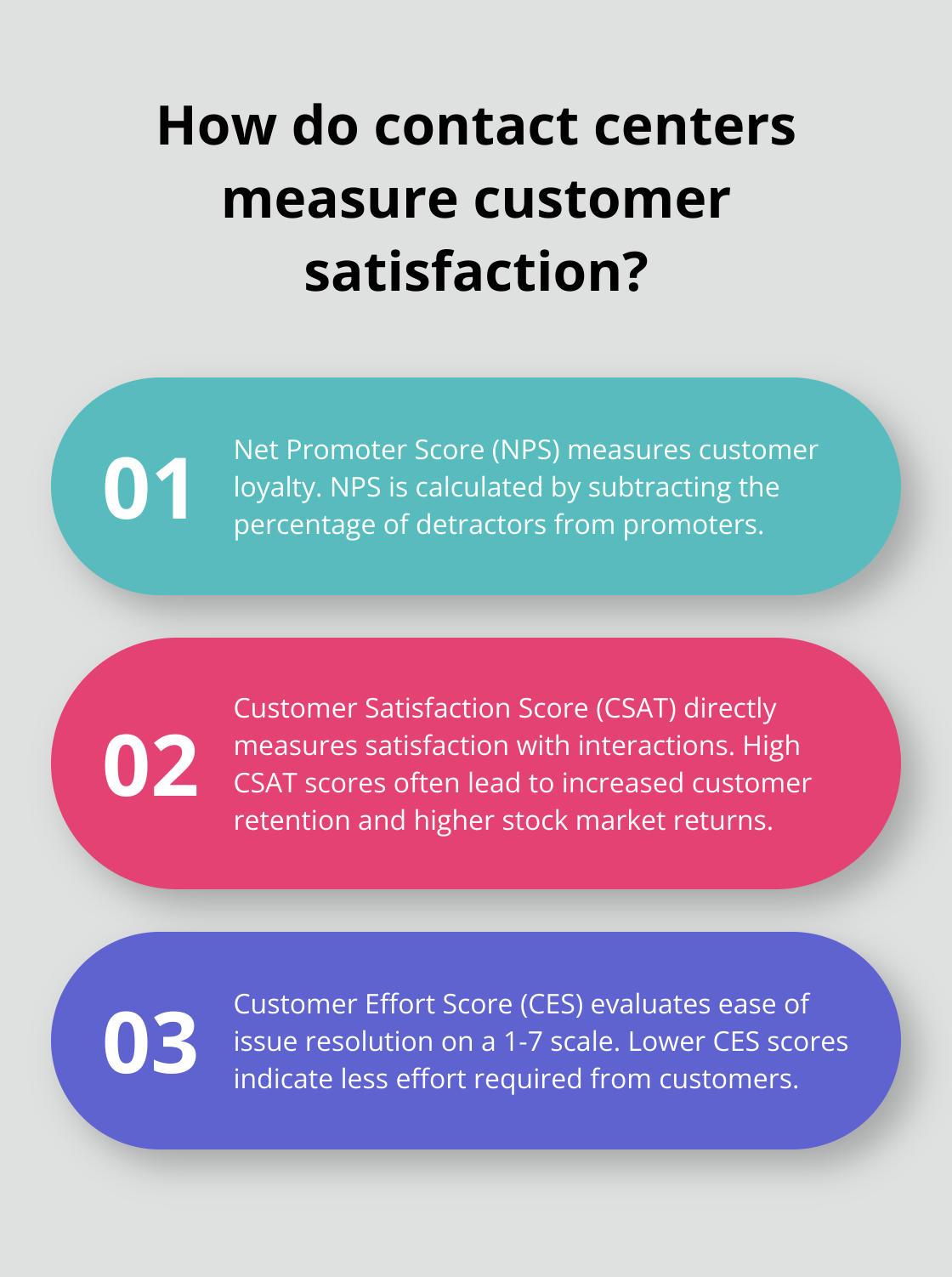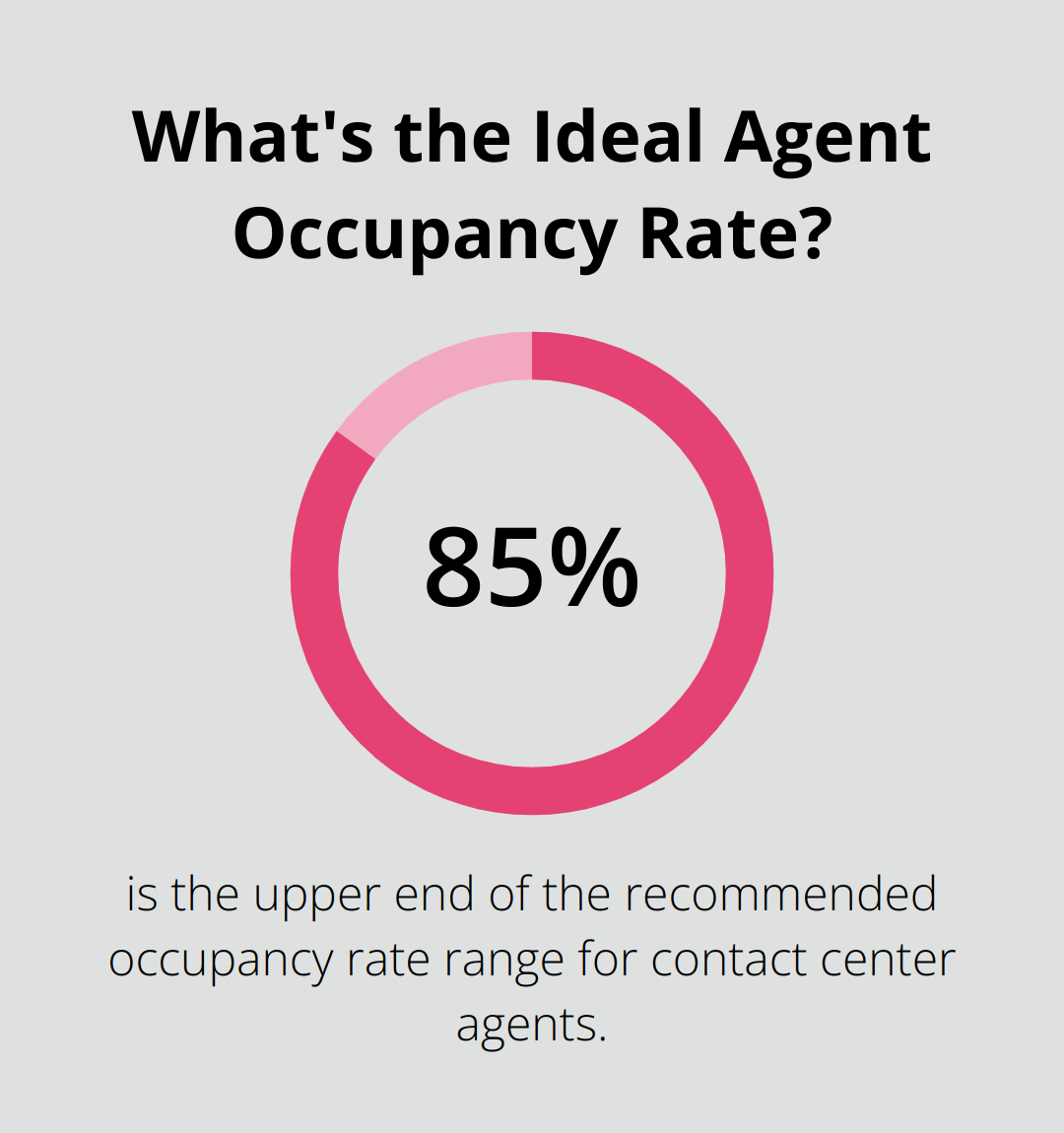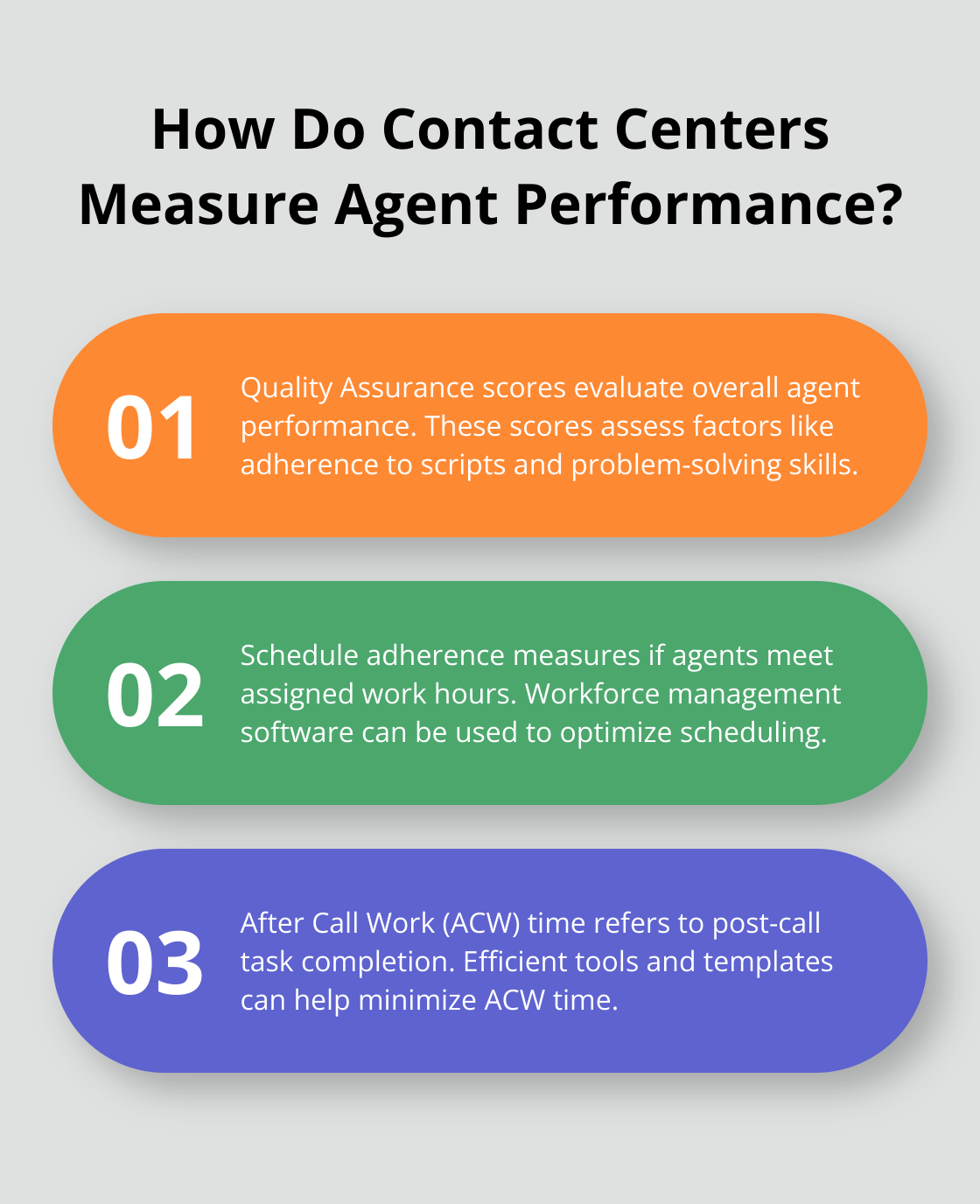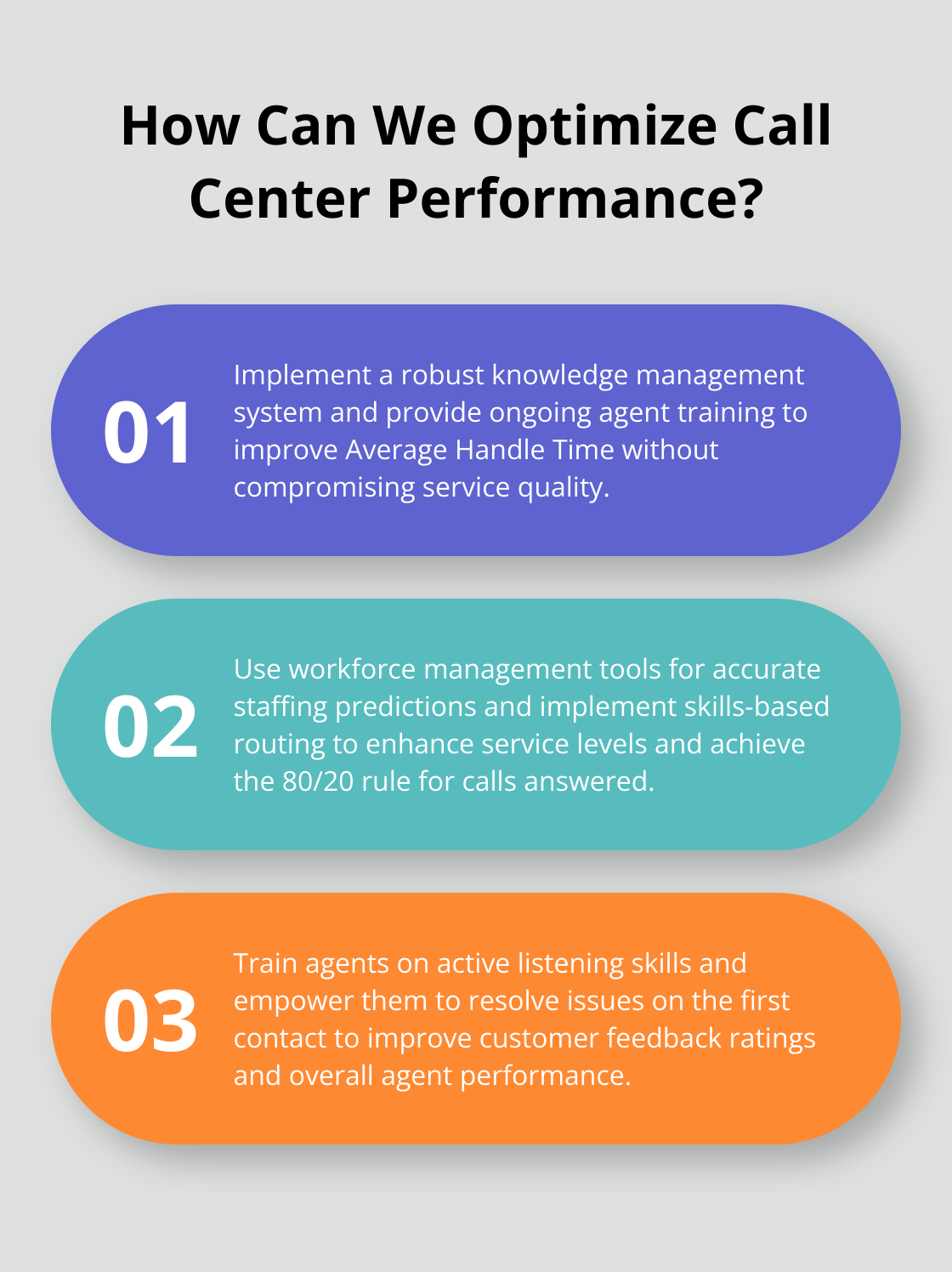Contact center key performance indicators (KPIs) are critical for measuring and improving customer service operations. At Outsource Consultants, we understand the pivotal role these metrics play in driving success and enhancing customer experiences.
This guide explores the most important KPIs across three key areas: customer satisfaction, operational efficiency, and agent performance. By focusing on these essential metrics, contact centers can optimize their operations and deliver outstanding service.
How to Measure Customer Satisfaction in Contact Centers
Customer satisfaction is the cornerstone of successful contact center operations. At Outsource Consultants, we have identified four key metrics that provide a comprehensive assessment of customer experience: Net Promoter Score (NPS), Customer Satisfaction Score (CSAT), Customer Effort Score (CES), and First Contact Resolution (FCR).
Net Promoter Score (NPS)
NPS measures customer loyalty by asking: “How likely are you to recommend our company to a friend or colleague?” Responses categorize customers into three groups:
- Promoters (9-10): Highly satisfied customers likely to recommend your business.
- Passives (7-8): Neutral customers who are satisfied but not enthusiastic.
- Detractors (0-6): Unhappy customers who may discourage others from using your service.
NPS Calculation: % Promoters – % Detractors
For instance, if 70% of respondents are promoters and 10% are detractors, the NPS score would be 60.
Customer Satisfaction Score (CSAT)
CSAT measures customer satisfaction with specific interactions or overall service. Customers typically rate their experience on a 1-5 or 1-10 scale.
Why CSAT Matters: According to the American Customer Satisfaction Index (ACSI), businesses with high CSAT scores experience increased retention and higher revenue growth.
Customer Effort Score (CES)
CES evaluates the ease with which customers resolve their issues. Research indicates that high-effort service experiences drive customer disloyalty and increase churn rates.
CES Calculation: Customers rate their experience on a 1-7 scale, where lower scores indicate minimal effort required.
First Contact Resolution (FCR)
FCR measures the percentage of customer issues resolved during the first interaction, reducing operational costs by eliminating repeat contacts.
Strategies to Improve Customer Satisfaction KPIs:
- Clearly define each metric and establish benchmarks.
- Set realistic improvement targets and review progress regularly.
- Train agents on the impact of these metrics.
- Use AI-powered analytics to track and enhance customer interactions.

Implementation Strategies
To implement these metrics effectively, follow these steps:
- Define each metric clearly
- Establish baseline measurements
- Set realistic improvement targets
- Review progress regularly
- Train agents on the importance of these metrics and their impact on scores
Maximizing Operational Efficiency in Contact Centers Key Performance Indicators
Operational efficiency ensures that contact centers handle customer interactions effectively. Five key KPIs help optimize efficiency: Average Handle Time (AHT), Service Level, Abandonment Rate, Occupancy Rate, and Average Speed of Answer (ASA).

Optimize Average Handle Time (AHT)
AHT measures the average time spent on a customer interaction, including talk time, hold time, and after-call work.
Benchmark: Many organizations aim for an AHT of 480 seconds (8 minutes), depending on industry standards.
How to Improve AHT:
- Implement knowledge management systems to provide quick answers.
- Use AI-driven analytics to identify bottlenecks.
- Optimize call routing to connect customers to the right agents faster.
➡ Read more about how outsourcing can help optimize AHT
Achieve Optimal Service Levels
Service Level measures the percentage of calls answered within a predefined timeframe.
Industry Standard: The 80/20 rule (80% of calls answered within 20 seconds) is a common benchmark.
Ways to Improve Service Levels:
- Use workforce management tools for precise staffing predictions.
- Implement skills-based routing to match calls with the best-qualified agents.
- Offer callback options to reduce customer wait times.
➡ Learn how nearshore call centers can improve service levels
Reduce Abandonment Rates
Abandonment Rate tracks the percentage of callers who hang up before speaking with an agent.
Strategies to Lower Abandonment Rates:
- Provide estimated wait times to set customer expectations.
- Offer self-service options for quick issue resolution.
- Optimize staffing during peak hours with AI-driven scheduling.
➡ Explore how outsourcing can reduce call abandonment rates
How to Measure Agent Performance in Contact Centers
Agent performance significantly impacts contact center success. Four key metrics provide a comprehensive view of agent effectiveness: Quality Assurance Score, Adherence to Schedule, Average After Call Work Time, and Customer Feedback Ratings.
Quality Assurance Score
Quality Assurance (QA) scores evaluate the overall performance of agents during customer interactions. These scores typically assess factors such as adherence to scripts, problem-solving skills, and communication effectiveness. To improve QA scores:
How to Improve QA Scores:
- Implement regular coaching sessions with constructive feedback.
- Utilize AI-powered speech analytics for real-time performance insights.
Adherence to Schedule
Schedule adherence measures whether or not call center agents adhere to their assigned schedules and meet the required work hours. To boost adherence:
Ways to Boost Adherence:
- Use workforce management software for optimized scheduling.
- Implement gamification strategies to encourage punctuality.
Average After Call Work Time
After Call Work (ACW) time refers to the period agents spend completing tasks related to a call after the customer interaction has ended. To minimize ACW time:
How to Reduce ACW Time:
- Automate routine documentation tasks.
- Train agents on efficient time management techniques.
Customer Feedback Ratings
Direct customer feedback provides invaluable insights into agent performance. Many contact centers use post-interaction surveys to gather this data. To enhance customer feedback ratings:
How to Enhance Customer Feedback Scores:
- Train agents in active listening and empathy.
- Empower agents to resolve issues on first contact.

Implementing these agent performance metrics requires a balanced approach. It’s important to track and improve these KPIs while considering the overall customer experience. Over-emphasizing metrics can sometimes lead to unintended consequences (such as agents rushing through calls to meet targets at the expense of quality service).
To strike the right balance, review and adjust your performance metrics regularly in line with your business goals and customer expectations. Use tools like speech analytics and customer journey mapping to gain a holistic view of agent performance and its impact on customer satisfaction.
Final Thoughts on Contact Center Key Performance Indicators
Tracking and optimizing contact center KPIs ensures long-term success in customer experience, operational efficiency, and agent performance. At Outsource Consultants, we specialize in KPI-driven strategies that improve performance, reduce operational costs, and enhance customer interactions.
If you’re looking to optimize your contact center operations, our team of experts can help. Contact us today to learn more about our tailored solutions for improving contact center performance.

FAQs About Contact Center KPIs
1. What are the most important KPIs for contact centers?
The key KPIs for contact centers include Net Promoter Score (NPS), Customer Satisfaction Score (CSAT), Customer Effort Score (CES), First Contact Resolution (FCR), Average Handle Time (AHT), Service Level, Abandonment Rate, and Agent Performance Metrics such as Quality Assurance Scores and Adherence to Schedule.
2. Why is First Contact Resolution (FCR) important?
FCR is critical because resolving a customer’s issue on the first interaction enhances satisfaction, increases customer retention, and reduces the need for repeat contacts—ultimately lowering operational costs.
3. What is considered a good Average Handle Time (AHT)?
A good AHT varies by industry, but many contact centers aim for 480 seconds (8 minutes) per call, including talk time, hold time, and after-call work. Lowering AHT without sacrificing service quality can improve both efficiency and customer experience.
4. What does the 80/20 rule mean in contact centers?
The 80/20 rule is a common benchmark for Service Level, meaning 80% of calls should be answered within 20 seconds. However, this standard can vary based on industry expectations and customer needs.
5. How can contact centers reduce call abandonment rates?
Reducing call abandonment rates can be achieved by:
- Providing estimated wait times to set expectations.
- Offering callback options so customers don’t have to stay on hold.
- Optimizing staffing levels during peak hours.
6. What is a good agent occupancy rate?
An ideal agent occupancy rate is between 75-85%, ensuring that agents are productive while minimizing burnout.
7. How does outsourcing impact contact center KPIs?
Outsourcing can significantly improve customer satisfaction, cost efficiency, and operational performance by leveraging skilled agents, AI-driven tools, and optimized workflows. More businesses are turning to outsourced call center solutions to enhance KPI performance.
8. What role does AI play in contact center efficiency?
AI enhances contact center efficiency through automated call routing, sentiment analysis, predictive analytics, and virtual agents, helping companies improve customer service while reducing costs.
9. How can companies improve CSAT (Customer Satisfaction Score)?
To improve CSAT, companies should:
- Train agents in active listening and problem resolution.
- Use AI-powered analytics to identify service gaps.
- Offer omnichannel support, including chat, phone, and email.
10. How can businesses start optimizing their contact center performance?
Businesses should begin with a KPI assessment to identify gaps in efficiency and customer experience. Partnering with a CX BPO consulting firm can help develop a tailored strategy for measurable improvements.






